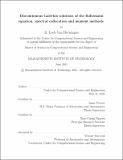Discontinuous Galerkin solutions of the Boltzmann equation: spectral collocation and moment methods
Author(s)
Van Heyningen, R. Loek
DownloadThesis PDF (1.819Mb)
Advisor
Peraire, Jaime
Nguyen, Ngoc-Cuong
Terms of use
Metadata
Show full item recordAbstract
This thesis explores the ability of the discontinuous Galerkin (DG) method to numerically solve the Boltzmann equation. Constructing numerical methods for this equation is a challenge, due in part to the kinetic theory description of moving particles, which relies on space, time, and velocity variables. Two novel approaches are presented and compared. The first uses a spectral collocation basis in velocity space. The resulting system is solved in time using Diagonally Implicit Runge-Kutta methods, chosen in order to mitigate stiffness concerns. A Jacobian-Free Newton—Krylov method is presented, accelerated with a sweeping preconditioner. The method is tested on 1D and 2D problems in order to validate its convergence behavior and investigate its efficiency. The second method uses DG for moment equations, which can be derived as spectral methods in velocity space with spatial and temporal adaptivity. These methods were first proposed in 1949 by Grad, but their applicability has been limited. The equations are not guaranteed to be hyperbolic, leading to stability issues. The elegance and potential for cost-reduction of Grad’s moment method have led to the development of different moment closures that preserve hyperbolicity and model accuracy. The approaches studied in this thesis, the globally hyperbolic moment methods, restore hyperbolicity by introducing a term that cannot be written in conservative form. The equations are typically solved with operator splitting and low-order methods. We examine the promise and challenges of applying a high-order DG method with explicit Runge-Kutta time-stepping to these equations on common 1D test cases. The thesis ends with a discussion on the prospects of both methods and suggestions for future work.
Date issued
2021-06Department
Massachusetts Institute of Technology. Center for Computational Science and EngineeringPublisher
Massachusetts Institute of Technology